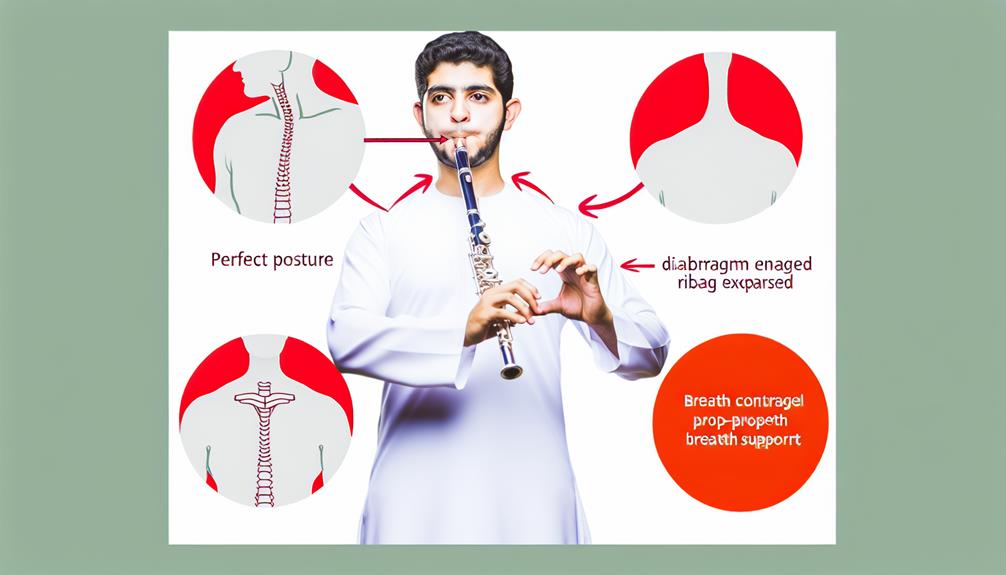Breath control and support serve as the backbone of a flutist's artistry, dictating the nuances and depth of their musical expression. As flutists aim to refine their technique, the mastery of breath becomes a defining factor in their ability to convey emotion and connect with their audience on a profound level. The exploration of breath control techniques and strategies not only enhances musical performance but also opens doors to a world of artistic possibilities waiting to be explored.
Key Takeaways
- Proper breath support ensures consistent tone and dynamics.
- Diaphragmatic breathing enhances lung capacity for sustained phrases.
- Maintain good posture to optimize airflow and control.
- Regular breathing exercises improve endurance and musicality.
- Collaborate with mentors for feedback on breath control techniques.
Introduction
Breath control lies at the heart of every flutist's technique, serving as the foundation upon which their musical expression is built. Understanding the nuances of breath support is vital for producing a rich, resonant tone and executing dynamic phrasing.
As we explore the significance of breath control for flutists, we will uncover the fundamental principles that underpin this essential aspect of flute playing.
Overview of breath control and support in flute playing
Skillful management of airflow is a fundamental aspect of achieving exquisite musical expression on the flute. To enhance this important skill, flutists can engage in various breathing exercises and mindfulness techniques. These practices not only increase lung capacity but also promote proper posture, allowing for ideal airflow control.
Additionally, maintaining good cardio fitness and incorporating core engagement exercises can greatly benefit a flutist's breath control and support. By developing these foundational aspects of breath management, flutists can access a world of possibilities in their musical performances.
The combination of intentional breathing techniques and physical conditioning creates a strong foundation for achieving a rich and resonant sound while playing the flute. Understanding the importance of breath control and support sets the stage for mastering the intricacies of flute playing and elevating the overall musical experience for both the performer and the audience.
Why breath control is essential for flutists
A flutist's ability to achieve musical excellence is intricately connected to their mastery of airflow management, which serves as the foundation for engaging performances.
Breath control is essential for flutists for a multitude of reasons. To begin with, proper breathing techniques not only enhance the sound quality produced but also aid in managing performance anxiety.
When a flutist has control over their breath, they can better focus on their musical expression, leading to a more engaging performance. Additionally, breath control contributes to a flutist's stage presence, allowing them to exude confidence and command the attention of their audience.
Lung capacity plays a pivotal role in sustaining long phrases and executing dynamic variations effectively. Through understanding and honing breath control, flutists can maximize their full potential, delivering performances that are not only technically proficient but also emotionally compelling.
Essentially, breath control is the cornerstone of a flutist's artistry, shaping their musical journey and captivating listeners with every note played.
Importance of Breath Control
Breath control is the cornerstone of a flutist's technique, playing a fundamental role in producing a beautiful sound and maintaining musicality.
Without proper breath control, flutists may encounter challenges such as inconsistent tone quality, limited dynamic range, and difficulties in phrasing.
Understanding the importance of breath control is essential for flutists to overcome these common issues and elevate their playing to a higher level of artistry.
Fundamental Role of Breath in Flute Playing
Breath serves as the cornerstone of a flutist's musical expression, essential for creating a resonant and vibrant tone.
The mastery of breath control not only impacts the quality of sound produced but also guarantees consistency in tone throughout a performance.
Understanding the fundamental role of breath in flute playing is paramount for achieving technical proficiency and emotive musicality.
Breath as the foundation of sound production
The mastery of breath control serves as the cornerstone upon which the intricate tapestry of flute playing is meticulously woven.
Breathing techniques, mindfulness, and physical fitness are crucial components for flutists to develop strong breath support.
Enhancing lung capacity and practicing breath holding exercises are essential for achieving the breath control necessary to produce a beautiful and consistent sound on the flute.
Impact on tone quality and consistency
Having a refined sense of breath control greatly influences the tone quality and consistency that a flutist can achieve during their performance.
Tone development is enhanced through precise breath control, while articulation precision relies on strong breath support.
Consistent breath control also allows for greater musical expression, ensuring that the flute player can convey emotions and convey a cohesive musical narrative effectively.
Breath Control and Musicality
Mastering breath control is not only essential for sustaining long phrases but also for infusing music with emotion and depth.
The ability to manipulate airflow directly impacts a flutist's capacity to convey musical nuances and interpretive elements.
How breath control affects phrasing and expression
A flutist's ability to control their breath directly influences the phrasing and expression of their music, elevating the depth and emotional resonance of their performance. Phrasing techniques, breath control, expressive playing, breath support, and musical interpretation are all intricately linked to the mastery of controlled breathing.
Through precise management of breath, flutists can shape phrases, infuse their music with emotion, and bring their interpretations to life with unparalleled clarity and beauty.
Enhancing musical interpretation through controlled breathing
The artistry of musical interpretation is intricately interwoven with the mastery of controlled breathing, illuminating the nuanced depths of expression and emotion within a flutist's performance.
Breathing mindfulness enhances musical phrasing, allowing for smooth shifts between notes and phrases.
Through the utilization of expression techniques like dynamic control and shaping of phrases with breath, flutists can convey a wide spectrum of emotions, enchanting audiences with their musical storytelling.
Common Issues Due to Poor Breath Control
Effective breath control is vital for flutists as it directly impacts their performance. Common issues arising from poor breath control include inconsistent tone production, difficulties in sustaining notes, and limitations in achieving a wide dynamic range.
Mastering breath control is essential for flutists to enhance their musical expression and overall performance quality.
Inconsistent tone
Consistently achieving a clear and beautiful tone on the flute relies heavily on mastering the art of breath control. Improving airflow through proper breathing techniques enhances musicality and expands dynamic range. Here's a visual representation to help you understand the importance of breath control in achieving a consistent tone:
| Tone Consistency | Improving Airflow | Breath Control |
|---|---|---|
| Musicality | Dynamic Range |
Difficulty sustaining notes
Struggling to sustain notes while playing the flute often stems from insufficient breath control, hindering the ability to maintain a consistent sound throughout musical phrases.
Overcoming breath stamina challenges requires techniques such as pacing breath support and improving breath endurance.
Impact on dynamic range
Insufficient breath control not only impacts a flutist's ability to sustain notes but also greatly influences the dynamic range they can achieve while playing. Breath control is essential for volume modulation, allowing for a wide dynamic range.
Mastering breath technique enhances musical dynamics, enabling the performer to expressively navigate through soft, subtle passages to powerful, resonant climaxes. Proper breath support is the cornerstone of achieving nuanced and engaging musical performances.
Breathing Exercises for Flutists
Mastering breathing exercises is essential for flutists to enhance their performance.
By focusing on basic breathing techniques, breath awareness exercises, and practical breathing exercises, flutists can strengthen their breath control and overall musicality.
Incorporating these exercises into daily practice routines can lead to improved tone quality, endurance, and musical expression.
Basic Breathing Techniques
In mastering the art of breath control for flutists, it is essential to understand basic breathing techniques. Techniques such as diaphragmatic (abdominal) breathing and rib expansion play a vital role in optimizing lung capacity utilization.
Diaphragmatic (abdominal) breathing
When developing breath control as a flutist, mastering the technique of diaphragmatic (abdominal) breathing is essential for achieving excellent sound quality and performance.
This technique involves deep inhalations that engage the diaphragm, providing strong abdominal support for sustained notes and phrases.
Rib expansion and lung capacity utilization
To achieve peak breath control and enhance performance quality, flutists must focus on expanding their rib cage and effectively utilizing their lung capacity through specific breathing exercises.
- Rib expansion: Enhances airflow efficiency.
- Lung capacity: Maximizes breath support.
- Breath awareness: Improves control and stability.
- Diaphragmatic breathing: Engages the primary breathing muscle.
- Core engagement: Strengthens support for sustained phrases.
Breath Awareness Exercises
Breath awareness exercises are fundamental for flutists looking to improve their breath control and overall performance. These exercises focus on mindfulness and help flutists connect with their breath in various parts of their body.
Mindful breathing practices
Engaging in mindful breathing practices is essential for flutists to cultivate a deep connection between their breath and music, fostering a harmonious and expressive performance.
- Enhances focus: Mindful breathing directs attention to the present moment.
- Reduces anxiety: Controlled breath calms the nerves before performances.
- Promotes body awareness: Connecting breath with movement enhances performance quality.
- Improves lung capacity: Mindful breathing exercises enhance respiratory strength.
- Enhances musical phrasing: Controlled breath supports dynamic nuances in music.
Exercises to feel the breath in different parts of the body
Developing a keen awareness of the breath's presence in various parts of the body is a fundamental practice for flutists seeking to deepen their connection to their instrument and enhance their musical performance.
Breath awareness exercises help flutists feel the energy flow through different body regions, fostering a stronger body connection.
Practical Breathing Exercises
Starting on a journey to enhance breath control for flutists requires a strategic approach that includes specific breathing exercises.
Incorporating breathing gym routines, focusing on slow inhalation and exhalation exercises, and mastering the technique of breathing through a straw can greatly improve respiratory capacity and control.
These practical exercises serve as fundamental tools to cultivate a strong foundation for best performance and musical expression on the flute.
Breathing gym routines
To optimize their respiratory capacity and enhance their flute playing performance, flutists can benefit greatly from integrating structured breathing gym routines into their practice regimen.
These routines not only improve lung capacity and breath control but also promote mindfulness and overall fitness.
Some key exercises include diaphragmatic breathing, pursed lip breathing, ribcage expansion exercises, and interval training to strengthen respiratory muscles.
Slow inhalation and exhalation exercises
Slow inhalation and exhalation exercises are fundamental components of a flutist's breathing practice. They are essential for cultivating control and precision in their musical performance. These exercises not only enhance breath relaxation techniques and mindfulness practice but also play an important role in improving breath control in performance and stage presence.
Additionally, they contribute to better breath support in ensemble playing, fostering collaboration skills among musicians.
Breathing through a straw technique
Implementing the breathing through a straw technique can greatly enhance a flutist's breath control and efficiency during musical performances, leading to improved tone quality and stamina.
- Breath control benefits: Enhances lung capacity
- Drawbacks: Potential strain if done excessively
- Breathing through straw alternatives: Lip trills, diaphragmatic breathing
- Impact of straw technique on tone: Helps achieve a focused and supported sound
- Overall impact: Strengthens respiratory muscles for sustained playing
Incorporating Breathing Exercises into Practice
Mastering the flute requires not only technical skill but also a deep understanding of breath control.
Incorporating specific breathing exercises into your daily practice routine can greatly enhance your playing capabilities.
Daily routines for breath control
Incorporating effective breath control exercises into daily practice routines is essential for flutists aiming to enhance their performance capabilities and overall musical expression.
To improve breath control, flutists can incorporate the following into their daily routines:
- Practice diaphragmatic breathing
- Focus on breath awareness
- Utilize breathing exercises
- Incorporate mindfulness techniques
- Set specific breath control goals
Combining breathing exercises with playing
To enhance their flute playing skills and deepen their breath control proficiency, flutists can integrate specific breathing exercises seamlessly into their practice sessions.
By incorporating breathing techniques, flutists can improve performance, enhance breath awareness to elevate musicality, and develop breath support for better expression.
These exercises not only strengthen the respiratory system but also cultivate a deeper connection between breath control and musical expression in performance.
Techniques to Improve Breath Support
Mastering techniques to enhance breath support is essential for flutists aiming to achieve peak performance.
By understanding the intricacies of breath support and the vital role posture plays in this process, flutists can maximize their full potential.
Engaging core muscles effectively and managing breath flow during performances are key elements to maintain a steady and controlled sound production.
Understanding Breath Support
Understanding proper breath support is essential for flutists to produce a rich, resonant tone.
By differentiating between breath support and breath control, flutists can develop a deeper understanding of how the diaphragm and intercostal muscles play an important role in sustaining a steady airflow while playing.
Mastering techniques to improve breath support can enhance a flutist's performance by providing greater control over dynamics and phrasing.
Difference between breath support and breath control
In the domain of flute playing, differentiating between breath support and breath control is essential for achieving peak performance and tone quality.
- Breath support: Focuses on maintaining a steady airflow for sustained phrases.
- Breath control: Involves the regulation of airflow for dynamics and articulation.
- Breath awareness: Being mindful of inhalation and exhalation patterns.
- Controlled exhalation: Releasing air with precision and control.
- Lung expansion: Maximizing the capacity of the lungs for best breath control.
Role of the diaphragm and intercostal muscles
To enhance breath support in flute playing, a deep understanding of the coordination between the diaphragm and intercostal muscles is paramount. Diaphragmatic breathing is essential for controlling airflow, aiding in managing performance anxiety. The intercostal muscles support breath control, allowing for deep breathing, crucial for sustained musical expression. Mastering the dynamics between these muscle groups is fundamental for flutists aiming to achieve optimal breath support and musicality.
| Diaphragmatic Breathing | Performance Anxiety |
|---|---|
| Intercostal Muscles | Breath Control |
| Deep Breathing | Musical Expression |
Posture and Its Impact on Breath Support
Maintaining proper posture is essential for flutists to achieve the best breath support while playing. Correct alignment of the body not only enhances breath control but also helps in producing a more resonant tone.
Engaging in exercises specifically designed to improve posture and breath alignment can greatly benefit flutists aiming to elevate their performance quality.
Correct posture for optimal breath support
Achieving ideal breath support on the flute begins with cultivating a posture that allows for efficient airflow and control.
- Maintain Correct Alignment: Align your head, neck, and spine to optimize breath control.
- Practice Good Posture: Sit or stand with an upright posture to support deep breathing.
- Utilize Breathing Techniques: Explore diaphragmatic breathing for peak support.
- Enhance Breath Awareness: Focus on the sensation of breath entering and leaving your body.
- Engage Core Muscles: Strengthen your core to stabilize breathing mechanisms.
Exercises to improve posture and breath alignment
Cultivating proper posture through targeted exercises is key to enhancing breath alignment and support for flutists.
Posture correction plays an essential role in maintaining ideal breathing alignment, which is important for producing clear and resonant tones.
Engaging Core Muscles for Support
To enhance breath support, flutists can benefit greatly from engaging their core muscles effectively. Core strengthening exercises like planks and Pilates can help develop the necessary strength and stability.
Techniques such as drawing the navel towards the spine and maintaining good posture while playing can further support the engagement of core muscles for improved breath control.
Core strengthening exercises
Engaging the core muscles through specific strengthening exercises is essential for flutists looking to enhance their breath support and control while playing. These exercises not only build strength but also improve stability, aiding in better core activation to support breath control. Incorporating breathing techniques with core strengthening can elevate a flutist's performance.
Here are some core strengthening exercises worth exploring:
- Planks
- Russian twists
- Bicycle crunches
- Dead bugs
- Mountain climbers
Techniques to engage the core while playing
How can flutists effectively integrate core engagement techniques into their playing to enhance breath support and control?
By focusing on core engagement, flutists can establish a strong breath connection, leading to improved performance benefits such as enhanced tone quality, better breath control, and increased endurance.
Engaging the core muscles while playing the flute not only supports the body but also aids in producing a more resonant and stable sound.
Managing Breath During Performance
As flutists, mastering breath management during performances is vital for delivering a polished and controlled musical experience. Techniques such as controlled exhalation and adjusting breath support for various musical passages are essential to maintaining consistent sound quality.
Techniques for controlled exhalation
To enhance their musical performance and achieve peak breath control, flutists must master techniques for controlled exhalation, ensuring a consistent and supported airflow throughout their playing.
- Breath regulation: Establishing a steady rhythm for inhaling and exhaling.
- Exhalation precision: Releasing air with control and accuracy.
- Support techniques: Engaging core muscles to maintain airflow.
- Relaxation: Keeping the body tension-free for efficient breathing.
- Efficiency: Maximizing airflow output for sustained musical phrases.
Tips for breath management in different musical passages
Effective management of breath in various musical passages is essential for flutists seeking to deliver dynamic and expressive performances. By mastering breath control techniques, flutists can navigate performance challenges with ease.
Implementing breath management strategies, especially in musical phrasing, allows for smooth shifts between notes.
Breath support exercises are crucial for enhancing dynamic range control, enabling flutists to convey emotions effectively through their music.
How to Increase Your Lung Capacity
Improving your lung capacity is essential for flutists aiming to enhance their breath control.
Lung expansion exercises, such as diaphragmatic breathing techniques, can help increase the capacity of your lungs.
Aerobic exercises tailored for musicians, along with breath-holding and sustaining exercises, are beneficial methods to boost lung capacity and stamina for playing the flute.
Lung Expansion Exercises
To excel in playing the flute, mastering breath control is essential. Lung expansion exercises play a vital role in enhancing your lung capacity, allowing for sustained and controlled airflow.
Techniques like stretches and specific exercises can help improve your lung flexibility, enabling you to produce richer, more resonant tones while playing.
Techniques to increase lung capacity
Taking deep breaths and practicing lung expansion exercises are foundational techniques for flutists looking to increase their lung capacity.
- Breathing exercises: Diaphragmatic breathing and pursed lip breathing.
- Lung capacity training: Incentive spirometry and power breathing.
- Respiratory health tips: Stay hydrated and avoid smoking.
- Posture: Maintain good posture to optimize lung expansion.
- Consistency: Regular practice of these techniques is key to seeing improvement.
Stretches and exercises to improve lung flexibility
Improving lung flexibility through targeted stretches and exercises is essential for enhancing breath control and performance quality in flutists.
Incorporating breathing techniques and flexibility training into daily practice routines can effectively increase lung capacity and breath control.
Stretching exercises that focus on expanding the rib cage and diaphragm, along with specific breathing exercises, help flutists develop stronger respiratory muscles, allowing for sustained and controlled airflow while playing.
Aerobic Exercises for Flutists
Aerobic exercises play an important role in enhancing a flutist's lung capacity and overall breath control. Engaging in activities like running, swimming, or cycling can greatly improve cardiovascular fitness, which directly impacts your ability to sustain long phrases and play with greater control and endurance.
Benefits of cardiovascular fitness for lung capacity
Enhancing cardiovascular fitness through targeted exercises can greatly boost a flutist's lung capacity, ultimately improving their breath control and performance quality.
Regular aerobic workouts bring numerous benefits, including increased oxygen intake, better endurance, and enhanced respiratory health. These advantages directly translate to improved flute performance, allowing musicians to sustain longer phrases and produce richer tones effortlessly.
Recommended aerobic exercises (running, swimming, etc.)
Targeted aerobic exercises such as running and swimming play a crucial role in enhancing a flutist's lung capacity, leading to improved breath control and musical performance quality.
These exercises not only increase oxygen intake but also strengthen the respiratory muscles, allowing flutists to sustain longer phrases without compromising tone quality.
Incorporating aerobic workouts into a flutist's routine guarantees enhanced fitness for flutists, ultimately benefiting their overall musical performance.
Breath Holding and Sustaining Exercises
To enhance your lung capacity and breath control as a flutist, engaging in timed breath holding techniques and incorporating long-tone exercises are crucial.
These exercises not only help in increasing the capacity of your lungs but also aid in sustaining your breath for longer periods, allowing for smoother and more controlled airflow while playing the flute.
Consistent practice of these techniques can greatly improve your overall respiratory endurance and performance as a flutist.
Timed breath holding techniques
Developing a flutist's lung capacity can be greatly enhanced through the practice of timed breath holding techniques, a fundamental aspect of improving breath control for playing the flute. Timed exercises help in building endurance and control over breath retention, promoting relaxation. They enhance mindful breathing, important for peak performance. These exercises require focus, aiding in strengthening the lungs and increasing overall breath capacity.
- Improve lung capacity
- Enhance breath control
- Promote relaxation
- Boost endurance
- Develop focus
Long-tone exercises to sustain breath
Enhancing lung capacity and breath control in flutists can be further achieved through the practice of long-tone exercises designed to sustain breath. This is an essential component in improving overall performance and musical expression.
These exercises help build breath support, endurance, and sustained breathing, enhancing stamina. Flutists can track progress by challenging themselves with longer durations, gradually increasing the difficulty to strengthen their respiratory muscles and enhance their playing capabilities.
Combining Physical Fitness with Flute Practice
To optimize your flute playing abilities, syncing physical fitness with practice sessions is key.
Incorporating targeted exercises that enhance lung capacity and overall endurance will greatly benefit your performance.
Setting measurable goals and tracking your progress will help you stay motivated and continuously improve your respiratory strength for a more controlled and powerful musical delivery.
Integrating fitness routines into daily practice
Integrating fitness routines into your daily flute practice can greatly enhance your lung capacity and overall performance on the instrument.
- Engage in cardio exercises to boost endurance.
- Include core strength workouts for better breath control.
- Practice yoga or Pilates to improve posture and lung expansion.
- Incorporate interval training to increase stamina.
- Maintain proper hydration and nutrition for best physical condition.
Monitoring progress and setting goals for lung capacity
Developing a systematic approach to evaluating your progress and setting targeted goals for enhancing your lung capacity is fundamental to the synergy of physical fitness and flute practice.
Regularly evaluating your lung capacity development and setting specific benchmarks can help track improvements in breath control.
Conclusion
To sum up, mastering breath control is essential for every flutist's musical journey.
By summarizing the key points covered in this article, flutists can reinforce their understanding and commitment to regular breath control practice.
As musicians progress, exploring advanced techniques can further enhance their breath control skills and elevate their performance abilities.
Summary of key points
A thorough understanding of breath control techniques is essential for flutists to enhance their musical expression and performance quality. Proper breath control allows for sustained phrases, dynamic contrasts, and overall control over the tone produced.
Here is a summary of key points to remember:
- Breathing exercises: Regular practice of breathing exercises such as diaphragmatic breathing and lip trills can help strengthen the respiratory muscles and improve breath capacity.
- Breath awareness: Developing a heightened awareness of how breath moves through the body and how it affects tone production is critical for flutists to maintain consistency in their playing.
- Mindful practice: Engaging in mindful practice sessions where focus is placed on breath control can lead to significant improvements in tone quality and musical interpretation.
- Posture: Maintaining good posture while playing the flute is essential for effective breath control and support.
- Consistency: Consistent practice of breath control techniques is key to integrating them seamlessly into performance, ensuring a polished and expressive musical delivery.
Encouragement to maintain regular breath control practice
Regular and consistent practice of breath control techniques is imperative for flutists looking to enhance their musical prowess and performance quality. Breath control challenges may arise, but with dedication and perseverance, these can be overcome.
To maintain motivation for practice, setting specific goals is essential. These goals could include increasing the length of phrases played without taking a breath, improving the control of dynamics through breath support, or mastering challenging passages that require precise breath management.
By tracking progress regularly, flutists can observe their improvement over time, which can be incredibly encouraging. Progress tracking techniques could involve recording practice sessions to review later, keeping a practice journal to note achievements and areas for improvement, or working with a teacher to assess breath control development.
Next steps for advanced breath control techniques
To further refine their breath control skills, advanced flutists can explore nuanced techniques that elevate their musical performance to new heights. Mastering advanced techniques not only enhances breath control mastery but also reveals a deeper level of musical expression and artistry.
Here are some next steps for advanced breath control techniques:
- Circular Breathing: Learn to inhale through the nose while maintaining a continuous sound on the flute, enabling seamless phrasing and extended musical passages.
- Dynamic Control: Practice controlling the intensity of your breath to create a wide range of dynamics, adding depth and emotion to your performance.
- Extended Breath Support Exercises: Engage in exercises that challenge your lung capacity and endurance, allowing for sustained phrases and complex musical passages.
- Integration with Musical Interpretation: Connect breath control techniques with musical interpretation to convey emotions and tell a story through your playing.
- Collaboration and Feedback: Work with fellow musicians or a mentor to receive feedback on your breath control techniques, fostering continuous growth and artistic development.
Frequently Asked Questions
Can Breath Control Help With Playing High Notes on the Flute?
Breath control plays an important role in enhancing performance outcomes for musicians. It greatly impacts endurance, confidence, and tone quality.
When it comes to playing high notes on the flute, mastering breath control is essential. Proper support and control not only allow flutists to reach those challenging high notes with ease but also contribute to a more confident and resonant sound production overall.
Is There a Specific Diet That Can Improve Breath Support for Flutists?
Nutrition plays a vital role in enhancing breath support for musicians. A diet rich in fruits, vegetables, lean proteins, and whole grains can provide the necessary nutrients for peak lung function.
Additionally, incorporating breathing exercises like diaphragmatic breathing and pursed lip breathing can strengthen respiratory muscles. Staying well-hydrated is also key to maintaining proper lung function.
How Can Breathing Techniques Be Applied to Different Musical Styles?
Breathing techniques play an essential role in musical expression across various genres.
In jazz improvisation, mastering controlled breath allows for fluid phrasing and dynamic interpretation.
Classical performance demands sustained breath support to navigate intricate passages with finesse.
Folk music and rock bands benefit from powerful breath control to amplify energy and drive.
World music and pop songs rely on nuanced breathing to infuse authenticity and emotion into diverse musical styles.
Are There Any Special Considerations for Breathing While Playing in a Group?
When engaging in group performances, one must navigate the intricate dance of ensemble dynamics. Understanding the nuances of breathing coordination within a collective setting is essential for seamless musical cohesion.
Considerations such as matching breath lengths, maintaining consistent airflow, and adapting to the group's tempo and phrasing are crucial for a harmonious and synchronized performance.
Embracing these elements fosters a shared musical journey that elevates the overall experience for both performers and audiences alike.
Can Breath Control Exercises Benefit Overall Physical Health?
Engaging in breath control exercises can indeed benefit overall physical health. Practices like yoga offer numerous benefits, such as increased flexibility, strength, and stress reduction.
Pilates, known for its focus on core strength and alignment, can improve posture and muscle tone.
Additionally, meditation has been shown to enhance mental clarity, reduce anxiety, and promote relaxation.
These practices collectively contribute to improved physical and mental well-being, making them valuable additions to one's wellness routine.
Conclusion
To sum up, mastering breath control and support is crucial for flutists to achieve peak performance. By refining their breath awareness, practicing breathing exercises, and enhancing lung capacity, flutists can improve their musicality and endurance.
These techniques elevate their playing to new heights, allowing for nuanced interpretation and dynamic range. Embrace the power of breath control and support to realize your full potential as a flutist.






